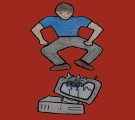
PAC III Computers
617 N Franklin Cuba, MO 65453 573-885-0024
PAC III Computers recommends
NOD32 Anti-Virus
Named the "Best Antivirus Product of 2006" by AV-Comparatives.org
Computer Terms and Definitions
BIOS - (Basic Input/Output System)
A collection of software codes that run the basic tasks of the computer. It takes care of sending data from one part of the computer to another. The BIOS is also known for the setup screen that is used to change some of the basic features of the computer, such as which device to start from, etc.
Boot or boot-up
The process that the computer goes through when it start up and performs all the routines necessary to get all the parts functioning properly, the loads the operating system. This term comes from the concept if lifting yourself up by the bootstraps.
Bot net
A network of computers that have been infected by a Virus or spyware program and are being secretly controlled over the internet by a malicious hacker.
CD - (compact disk)
A round plastic disk used to store data such as music, files and programs. The data is store in a spiral path starting at the middle and winding to the outer edge. CDs are considered Random Access Memory despite using a single path
Desktop
The area on the display screen where icons are grouped is often referred to as the desktop because the icons are intended to represent real objects on a real desktop.
DVD - (digital versatile disk)
A DVD is the same size as a CD but it hold about four times as much data. This is accomplished by winding the data path tighter, creating a longer path.
Format
The process of dividing a drive into parts that can be used to store data.
GUI - (Graphical User Interface)
(pronounced GOO-ee) A program interface that uses pictures (graphics) to make a program easier to use. Windows uses a GUI to make the computer easer to use than DOS which is no longer used. The GUI consists of several basic components: a Pointer (cursors), Icons, a Desktop, Windows, Menus, etc.
Icon
A small picture that represents Files, Folders, or commands. An icon usually has a little name under it as well.
Keyboard
It is a typewriter-like set of keys that allows you to enter data into a computer.
Link
A shortcut that takes you to a web page, file, folder. Links are mostly used on the Internet.
Login
To make a computer system or network recognize you so that you can begin a computer session. Most personal computers have no log-on procedure -- you just turn the machine on and begin working.
Menu
A list of commands that is separated from the rest of the items on a computer screen. The most common menu is the Right-Click Menu, which pops up when the right button of a mouse is pressed.
Microsoft Windows
SEE - Operating System
Monitor
The part of the computer that looks like a television. It allows you to see what is happening on the computer in real time.
Operating System
An Operating System is program that controls all the components of a computer. Microsoft Windows is the most common operating system. Every general-purpose computer needs an operating system. Operating Systems perform basic tasks like taking input from a mouse and keyboard and sending output to the monitor or a printer etc. It also keeps track of files and folders(directories).
P2P - (peer to peer)
File sharing networks where people share files directly with each other using special software.
PCI - (peripheral component interconnect)
PCI slots are little white slots approxomately four inches long. The allow you to connect items such as sound cards, modems, network cards, certain video cards, etc.
Pointer (cursor)
A symbol that appears on the monitor that is controlled by the mouse. It allows you to select objects such as Icons, Text, etc. or commands. It is usually a small arrow, but changes to an I-Beam pointer which is shaped like an uppercase I when over words and a hand when over links.
Programs
Programs are what make computers work, with out them a computer is useless. A program is like a recipe, it is an organized list of instructions that make a computer behave in a predetermined manner. It takes input from a user and tells the computer what to do with the input and how to output it when necessary.
Screen
SEE - Monitor
SPAM or Junk E-mail
The Internet was never intended to track every little thing that travels over it. In order for that to happen, every computer, router, and hub that transmits or relays information would have to keep a complete log. Some do but many do not, and the ones that don't keep the logs are used by hackers, spammers, etc. to stay anonymous on the Internet.
Anonymous spam is like taking a letter but putting someone else's return address then sticking it in a public mailbox. There is no way to trace it.
Spyware
Programs that track what you do on your computers and/or the internet.
Web page
A document made to be looked at over the internet.
Website
A collection of web pages belonging to one person or company.
Window
Windows divide the Screen into different areas. They can take up the whole Screen or only part of it. Windows can also lay on top of each other so that one may be partially or completely covered by another. You can move windows around the Screen, and change their shape and size at will.
